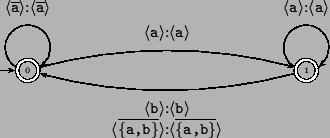
The minimization algorithm for transducers [25,27] can be applied to a bounded qpfst without modifications. The transducer minimization algorithm consists of two steps. In the first step, all output symbols are moved into preceding transitions as much as is possible. This is done by computing for each state the longest common prefix of the outputs associated with all paths from that state to a final state. The second step of the transducer minimization algorithm consists of the application of ordinary recognizer minimization to the resulting transducer, temporarily treating the labels as atomic symbols.
The application of the transducer minimization algorithm to a bounded qfst might result in a qpfst with identities in which the output has to be produced before the corresponding input symbol has been observed. The queue-mechanism can be generalized to treat such cases as well. We use an implementation of queues described in [33, page 299] in which an element can be dequeued before it is enqueued. The output is a variable temporarily; obviously this requires output to be buffered. We implemented this both in C++ as well as in Prolog.
However, applying the transducer minimization algorithm in this way does not neccessarily produce a minimal qpfst. One problem is that in the transducer minimization algorithm, the final step consists of an application of the recognizer minimization algorithm in such a way that the labels of the transducer are temporarily treated as unanalyzable atoms. This works in the case of ordinary transducers, but is not good enough for our purposes. The following example illustrates this particular problem.

The transduction implemented by this transducer is simply the
identity relation over ![]() . However, the application of the transducer
minimization algorithm will produce an identical transducer, rather
than the minimal one.
. However, the application of the transducer
minimization algorithm will produce an identical transducer, rather
than the minimal one.
In the implementation in the Fsa Utilities we have constructed a variety of heuristics, which includes a generalization of the transducer minimization algorithm, in order to reduce the size of deterministic transducers. In most practical cases, the heuristics produce a minimal transducer.